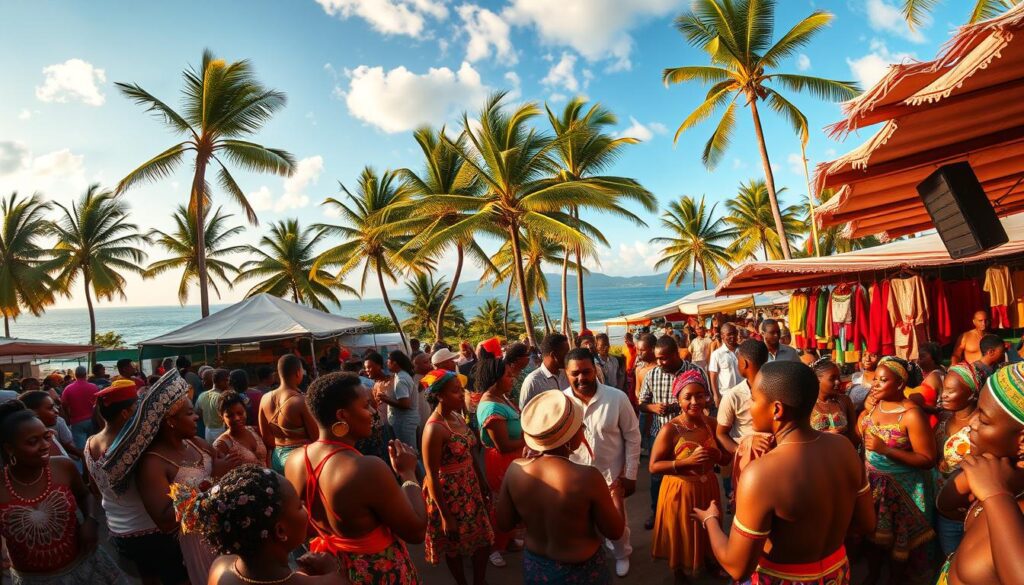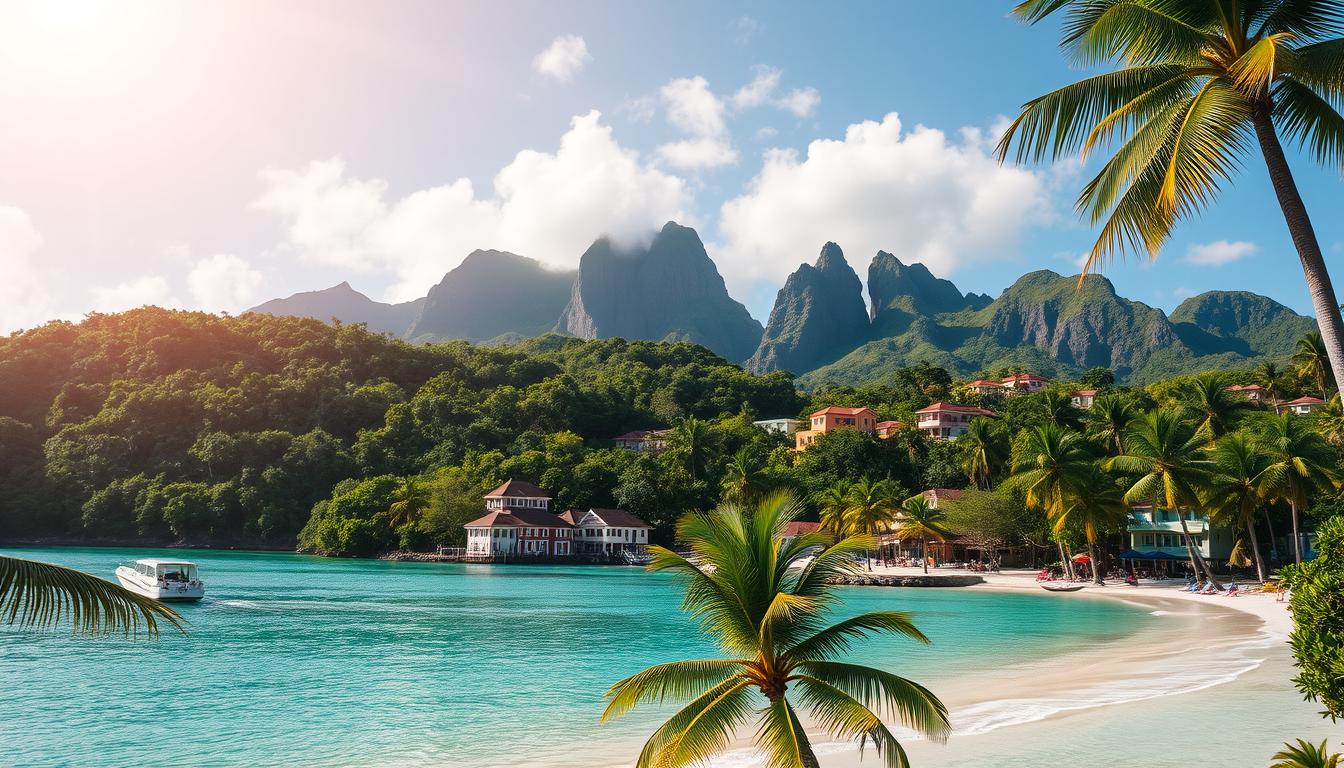Did you know 90% of Americans can’t locate this French territory on a map—despite it being part of France since 1946? Nestled in the eastern Caribbean, this butterfly-shaped archipelago offers European comforts alongside tropical beauty, making it one of the region’s most unique destinations.
Unlike typical Caribbean hotspots, here you’ll find crème brûlée served beside coconut-infused seafood and roadsigns pointing to both rainforest trails and Parisian bakeries. As a French overseas department, it blends EU infrastructure with Creole traditions, creating a culture you won’t experience anywhere else.
This guide unlocks everything from hidden volcanic beaches to lively markets bursting with spice-scented treasures. You’ll learn why its dual-island geography—nicknamed “the Butterfly”—offers twice the adventure, plus how its political status simplifies travel for international visitors.
Key Takeaways
- Discover a rare blend of French and Caribbean cultures in one destination
- Explore volcanic peaks, coral reefs, and UNESCO biosphere reserves
- Enjoy hassle-free travel with Euro currency and EU healthcare standards
- Experience Creole festivals and French-Caribbean fusion cuisine
- Find fewer crowds than neighboring islands despite world-class beaches
Introduction to Guadeloupe
You’ve found a hidden archipelago where French bakeries neighbor turquoise waters. This French overseas territory forms a butterfly-shaped group islands in the Lesser Antilles, blending European efficiency with Caribbean charm. Basse-Terre and Grande-Terre—the twin islands—anchor the archipelago, connected by mangrove-lined channels.
Discovering a Caribbean Treasure
Walk through Pointe-à-Pitre’s spice markets, then drive to Basse-Terre’s volcanic peaks—all within 45 minutes. As an overseas department, it operates like mainland France but pulses with Creole rhythms. You’ll spot EU-standard roads leading to secluded beaches where fishermen grill fresh lobster.
A Friendly Welcome to Your Ultimate Guide
With 375,700 residents spread across six islands, you get space to breathe. Marie-Galante’s sugarcane fields and Les Saintes’ pastel villages each tell unique stories. We’ll share essential information about ferry routes, local customs, and why this country-within-a-country simplifies travel planning.
Euro currency and French healthcare standards mean fewer surprises. Yet banana plantations and rum distilleries remind you this isn’t Paris—it’s better.
Geography and Natural Wonders
Imagine hiking an active volcano before lunch and snorkeling coral reefs by sunset—all without leaving one Caribbean destination. This archipelago’s dramatic contrasts form its greatest charm, with landscapes shifting from misty peaks to sugar-white shores across short ferry rides.
Island Layout: Basse-Terre, Grande-Terre, and More
The western Basse-Terre island dominates with its mountainous spine. Covering over half the territory’s land area, it hides rainforests where 300+ plant species thrive. You’ll drive winding roads past banana plantations to reach trailheads leading to waterfalls like Carbet Falls’ triple cascade.
Across the saltwater channel, flat Grande-Terre surprises with limestone cliffs and beach towns. Its eastern coast shelters calm waters perfect for kiteboarding, while southern Pointe des Châteaux offers Atlantic surf.
Volcanoes, Mountains, and Scenic Waterfalls
Soufrière Volcano towers 4,813 feet above sea level—the Caribbean’s highest peak. Though last erupting in 1977, its steamy vents still warm nearby hot springs. Three main trails let you choose between a 2-hour sulfur field walk or 5-hour summit climb.
| Island | Land Area | Landscape | Highlights |
|---|---|---|---|
| Basse-Terre | 848 km² | Volcanic mountains | La Soufrière, Carbet Falls |
| Grande-Terre | 586 km² | Limestone plains | Porte d’Enfer, Sainte-Anne beaches |
| Les Saintes | 13 km² | Cliff-lined bays | Fort Napoleon, Pain de Sucre |
Don’t miss the smaller islands. Les Saintes’ horseshoe bay rivals Mediterranean favorites, while Marie-Galante’s windmills recall its sugar-producing past. Each part of the archipelago reveals new natural wonders—from rare bird species to underwater caves.
Climate and Seasonal Variations
Picture this: You’re sipping fresh coconut water under swaying palms while gentle breezes keep the air crisp. This Caribbean paradise offers year-round warmth, but smart travelers plan around its subtle seasonal rhythms.
Tropical Temperatures and Trade Winds
Coastal areas maintain 77-82°F temperatures nearly every day—perfect for beach hopping. Northeast trade winds act like nature’s AC, cooling your skin even at midday. Head to Basse-Terre’s mountains? Temperatures drop to 61°F at higher elevations, with Soufrière’s summit sometimes hitting 39°F.
Understanding Dry and Rainy Seasons
From December to April (Creole Lent), expect minimal rain and endless sunshine—ideal for snorkeling clear waters. July through October brings afternoon showers that revive rainforests and fill waterfalls. Pro tip: Grande-Terre’s east coast gets 40 inches of rain yearly, while Basse-Terre’s peaks see over 100 inches.
- Pack light layers—trade winds prevent humidity buildup
- Visit May-June for shoulder season deals and blooming flowers
- Check weather apps: Storms rarely hit but forecasts stay updated
Hurricane season (May-November) brings more awareness than actual risk. Modern tracking systems give days of warning if storms approach. Most years, you’ll only experience brief tropical downpours that end as quickly as they begin.
Rich Culture and Creole Heritage
Your ears catch the syncopated beat of zouk music as the scent of Colombo spices fills the air—welcome to Guadeloupe’s living cultural mosaic. Here, French official language paperwork gets stamped to the rhythm of local Creole conversations, creating a bilingual dance that shapes daily life.

Local Traditions and Festivals
Colorful ribbons flutter around wrists during swatson street parties, each hue representing different ancestral roots. These all-night celebrations show how people honor African, Indian, and European influences through music and dance. Every year, Carnival transforms streets into moving theaters of elaborate costumes and satirical floats.
Art, Music, and Culinary Influences
Zouk music’s pulsing beats pair perfectly with rum cocktails made at family-run distilleries. In kitchens, French pastry techniques meet Caribbean ingredients—think coconut tarts beside cod fritters. Don’t miss Colombo curry, a fragrant dish tracing back to 19th-century Indian laborers.
| Tradition | Description | Cultural Influence |
|---|---|---|
| Madras Fabric | Vibrant checked textiles | West African & European fusion |
| Gwo Ka Drumming | Seven rhythmic patterns | African storytelling roots |
| Rum Production | 9 active distilleries | Colonial-era sugar trade legacy |
Artisans craft mahogany sculptures while painters blend tropical colors with Parisian styles. Through these creative expressions, people preserve history while shaping modern identity. It’s a culture where joie de vivre meets island time—always evolving, never rushed.
Historic Overview and Political Status
What if your Caribbean getaway came with EU healthcare and French pastry shops? This archipelago’s unique political status makes it possible. Since 1635, these islands have maintained strong European ties while crafting their own identity—even spending two years under Swedish rule during Napoleon’s era.
From Colonial Past to Present-Day French Overseas
Today, the territory operates as both an overseas department and region of France. This dual status means you’ll find:
- Euro currency accepted everywhere
- French emergency services on standby
- EU environmental protections for coral reefs
The political structure balances local needs with mainland France oversight. A French-appointed prefect works alongside elected councils—a system that’s evolved since Saint-Barthélemy and Saint-Martin became separate territories in 2007.
| Governing Body | Role | Impact on Visitors |
|---|---|---|
| Departmental Council | Manages local services | Well-maintained roads & beaches |
| Regional Council | Economic development | Vibrant cultural festivals |
| French State | National policies | EU safety standards |
This arrangement gives you European reliability without sacrificing Caribbean charm. As one historian notes: “It’s not just a tropical paradise—it’s France with palm trees.” You get Parisian-style pharmacies stocked with sunscreen beside rum stands selling ti-punch cocktails.
For travelers, this means seamless travel insurance coverage and familiar infrastructure. The French overseas department status transforms your vacation from a leap into the unknown to a culturally rich adventure with safety nets.
Experience Guadeloupe: A Blend of French and Caribbean Vibes
Ever sipped espresso on a beach where palm trees sway to French accordion tunes? This archipelago delivers Europe’s polish alongside island spontaneity. Crisp baguettes appear at rum shacks, while services meet EU standards—a rare combo that elevates your travel experience.
Where Paris Meets the Tropics
French remains the official language, but Creole rhythms flavor daily life. You’ll find three-star restaurants beside roadside bokit stands—all part of its charm. Road signs mirror mainland France, yet colorful madras fabrics remind you this destination dances to its own beat.
Simplified Island Hopping
Pointe-à-Pitre International Airport links you to Miami, Paris, and Montreal via major carriers. Ferries whisk you to Marie-Galante’s mills or Les Saintes’ cliffs within hours. EU citizens breeze through with IDs—others apply for specific travel requirements through French embassies.
Pack your sense of adventure (and euros). Whether diving coral gardens or savoring wine-soaked cheeses, this part of France promises Caribbean magic with European ease. Bon voyage!

